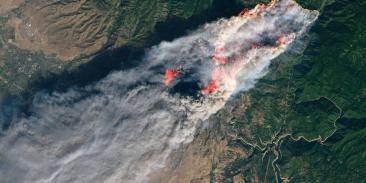More Pollution Cuts Needed To Protect Northeast From Acid Rain
A peer-reviewed study published in today’s BioScience underscores the need for further air pollution reductions to protect ecosystems from acid rain. The study chronicles the effects of acid rain on sensitive ecosystems in the Northeast, estimates the impacts of pollution reductions currently required under the Clean Air Act, and projects the ecosystem benefits from further cuts.
“The conclusions of the study are compelling,” said Michael Oppenheimer, chief scientist of Environmental Defense. “It shows that pollution cuts to date are a good beginning, rather than the solution, to the Northeast’s acid rain problem. The study documents the need for further reductions in air pollution that harms ecosystems in the Adirondacks, the Catskills, and throughout the Northeast.”
Acid rain occurs when emissions of sulfur dioxide (SO2) and oxides of nitrogen (NOx) in the atmosphere react with water and air pollutants to form acidic compounds. In the U.S., power plants produce nearly 70% of annual SO2 emissions and 25% of annual NOx emissions. The transportation sector — including passenger cars and trucks, large diesel trucks and buses, and nonroad engines — is responsible for about 50% of the nation’s annual NOx emissions.
The study reports that:
- Across the Northeast, acid deposition alters soils, stresses forest vegetation, acidifies lakes and streams, and harms fish and other aquatic life.
- Acid deposition has contributed to the decline of red spruce trees throughout the eastern U.S. and sugar maple trees in central and western Pennsylvania.
- Conservatively, 41% of Adirondack region lakes and 15% of New England lakes exhibit chronic and/or episodic acidification; 83% of the impacted lakes are acidic due to acid deposition.
- Current SO2 pollution reduction requirements for power plants are having a positive effect but will not adequately protect acid-sensitive ecosystems.
- An additional 80% reduction in SO2 pollution from power plants would facilitate the recovery of sensitive northeastern ecosystems in 20-25 years.
The full study can be found at: www.aibs.org/biosciencelibrary/vol51/mar01special.ldml and a summary can be found at: www.hbrook.sr.unh.edu/hbfound/hbfound.htm.
With more than 3 million members, Environmental Defense Fund creates transformational solutions to the most serious environmental problems. To do so, EDF links science, economics, law, and innovative private-sector partnerships to turn solutions into action. edf.org
Latest press releases
-
COMING SOON: An effort to weaken our popular chemical safety law
December 8, 2025 -
Groups File Lawsuit Challenging Trump EPA Final Rule That Delays Methane Pollution Protections from Oil and Gas Industry
December 4, 2025 -
New Statewide Survey: As Electricity Demand and Costs Skyrocket, Arizonans Support Building More Wind and Solar Energy
December 4, 2025 -
Trump Administration Announces Plan to Weaken Fuel Economy Standards for Cars and Trucks
December 3, 2025 -
Trump EPA Proposal Lowballs Risk of Cancer-causing Formaldehyde
December 3, 2025 -
New York Finalizes Greenhouse Gas Reporting Requirements for Major Polluters
December 2, 2025










